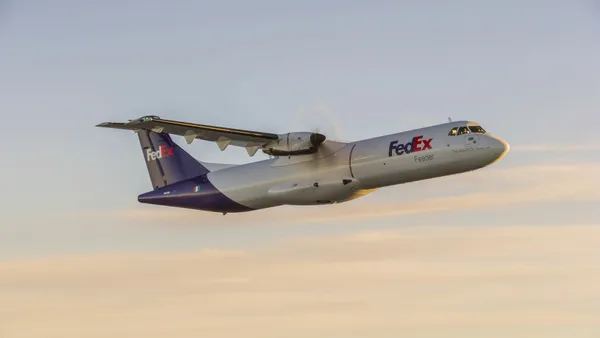Dive Brief:
- Air cargo demand was unhindered following a quick recovery from a massive global IT outage in July, which caused more than a week’s worth of flight delays and cancellations, according to an Aug. 1 report from Xeneta.
- However, cargo backlog in the immediate wake of the outage caused short-term panic among shippers and forwarders, pushing capacity prices to $2.70 per kilogram in the last week of July — the year’s highest level so far.
- “In July, had the IT outage taken longer to fix, we might have seen a slightly different outcome,” Xeneta Chief Airfreight Officer Niall van de Wouw said. “However, once again, air cargo showed resilience, after seeming to have dodged another major disruption. Going into the peak time of the year, airlines might just be starting to think their tailwinds will hold out.”
Dive Insight:
Air cargo activity continues to be buoyed by e-commerce volumes from Asia, and elevated demand is expected to extend through September — albeit partly due to the low base set in 2023, Xeneta reported.
Air cargo spot rates increased for the sixth consecutive month in July, averaging $2.66 per kilogram, up 20% year over year.
Cargo rates for shipments being transported between Southeast Asia and North America doubled year over year to $5.78 per kilogram. Meanwhile, potential port strikes in the U.S. East and Gulf Coasts — as well as Hamburg, Germany — could apply additional pressure to rates ahead of peak season, Xeneta said.
Ongoing Red Sea disruptions also have kept air freight spot rates afloat on certain trade lanes, according to the report. Issues like longer transport times alongside the recent unrest in Bangladesh could further drive up rates as port and airport backlogs may take a while to clear.
Shippers and freight forwarders have been bracing for elevated Q4 demand, with peak season already underway as of July, according to Xeneta. Companies like DHL Express and UPS plan to implement peak season surcharges while others are securing capacity to avoid constraints.
“For the air cargo market, it’s now all eyes on late August for the first signs of a proper peak season, which would be the cherry on top of the cake for airlines after such unexpected volumes and demand growth in the first seven months of the year,” said van de Wouw.














